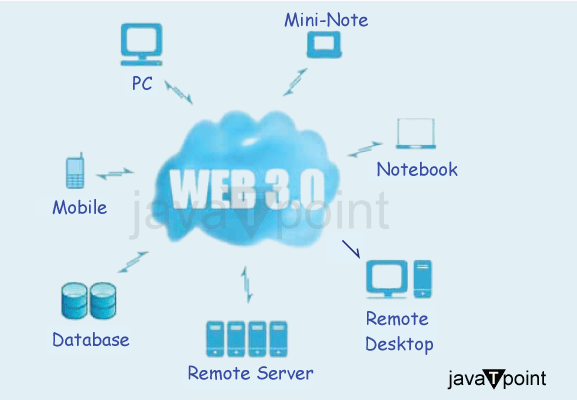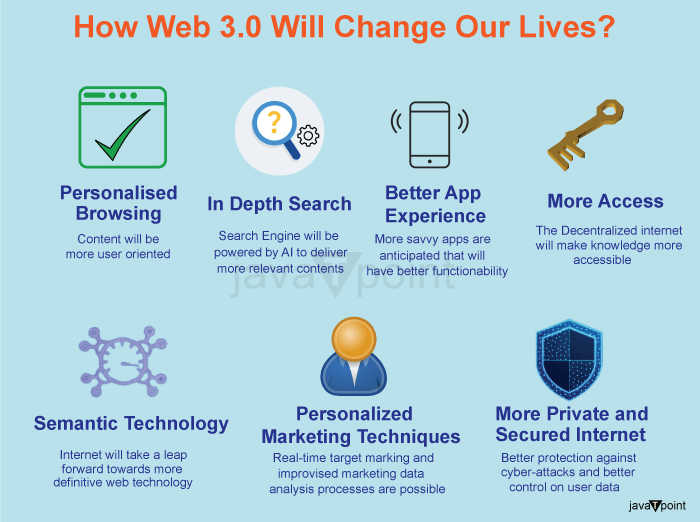How Web 3 Will Transform Our LivesThe third-generation internet, also known as Web 3.0, is the next phase in the evolution of the World Wide Web. It provides an information-driven semantic website with machine-based data understanding to create an increasingly connected and smarter web encounter for users. The current Internet is static and unable to adjust to the unique needs of each user. Web 3.0 is expected to be more collaborative and dynamic. It will rethink the surfing experience with structural changes to achieve democratic change across all aspects of the internet by leveraging blockchain and machine learning technology. Web 3.0 eliminates the need for centralised infrastructure by safely conserving data across an extensive range of devices. A comparable architecture also reduces the risk of severe data leakage. 
Web3: What is it?There are a minimum of three major stages in the evolution of the Internet. Until the early 2000s, Web 1.0 was made up hundreds of private web pages, a few prominent ones, and search engines. Then, with Facebook's ascent, a new Web 2.0 era typified by social media giants giving walled gardens emerged. Web 3.0, frequently referred to as Web3, aims to bring the Internet back to its roots. The next stage of the World Wide Web will use decentralisation to deconstruct walled gardens and give people back power. Content owners, for example, may quickly move assets across platforms and deliver content to customers with having to look for middlemen. Core characteristics of Web3 include:

Current Web3Several Web 3 technology are presently in use, but they are only the tip of the iceberg in terms of what is possible in the next years. As the blockchain technology, bitcoin along with other cryptocurrency browsers, and other parts of the Web3 network evolve, the capabilities of these platforms will become more prominent among the options available to clients.The following are a few instances of current Web3 technologies:
In 2022, the multiverse is also beginning to establish itself alongside these Web3 ideas. Google Glass and Facebook's Oculus combine the real and virtual worlds, while NVIDIA's Omniverse can build simulations to train robotics and autonomous vehicles. A new digital age may soon arrive as a result of these changes. What Will Web3 Do Next?Following patterns can be observed in the upcoming years: The development of forthcoming technologies will shape how Web3 evolves. For example, because to the excessively high gas costs in the initial incarnation of Unstoppable Domains, a single domain purchase may cost upwards of $200. Fortunately, because to the expansion of the Hexagon blockchain, the firm was able to lower these charges to zero, allowing anybody to establish NFT domains. Web3 refers to the shift to a decentralised communication powered by blockchain. Web 3.0, on the other hand, stems from Berners-Lee's original vision of the internet as a network of sites linking everything at the data level. The present internet may be viewed as a massive library of documents. Computers may obtain information for us if we request it.
Web3: Why Is It Important?The Web3 network's distributed and decentralised structure will make it more difficult for governments and large corporations to exert control over certain elements. That is why a lot of people are excited for it to debut. The advantages of the current web must also be taken into account, since it enables us to share knowledge, work together, and conduct business in ways that were before impossible. Therefore, even while we can't wait for Web3 to go live, we also shouldn't ignore the advantages of the current internet. The fact that the present web is open and simple to use is one of its most important benefits. Making websites that don't require any specialised software is simple compared to programming. What does Web3's future hold?
Numerous technological improvements made by Web3 are changing essential aspects of daily life. But what does the future hold for Web3? We've addressed the key reasons why Web3 symbolises the future of computers and cash, but how could Web 3 affect society overall whole? Web3 promotes financial freedom and helps to establish the framework for decentralised token-based economies. However, it is unknown how the Web 3 era will evolve in the future. Based on current statistics, the blockchain or crypto sectors are rapidly developing, although Web3 acceptance continues to be far from full. Individual user onboarding and company adoption are both fundamental prerequisites for broad Web3 adoption.Consumer fascination with Web3 services grows as a result of Web3 education. At the moment, only 300 million people utilise cryptocurrencies internationally, and many people remain ignorant of Web3's benefits. To summarise, the Web3 sector offers a lot of room for growth, and how rapidly it grows will be a key factor in deciding the answer to questions like "What will the next chapter of Web3?" ConclusionBlockchain technology provides an extensive set of features. Users may manage their funds by utilising electronic currencies and crypto wallets, for example. Users can use NFTs to tokenize assets and establish ownership. Metaverse settings provide a new set of virtual experiences. The possibilities are endless; Web 3 is still within its early phases of development. The growing number of Web3 creators, firms, and consumers demonstrates the industry's steady growth.
Next TopicTop web 3.0 benefits
|
 For Videos Join Our Youtube Channel: Join Now
For Videos Join Our Youtube Channel: Join Now
Feedback
- Send your Feedback to [email protected]
Help Others, Please Share










